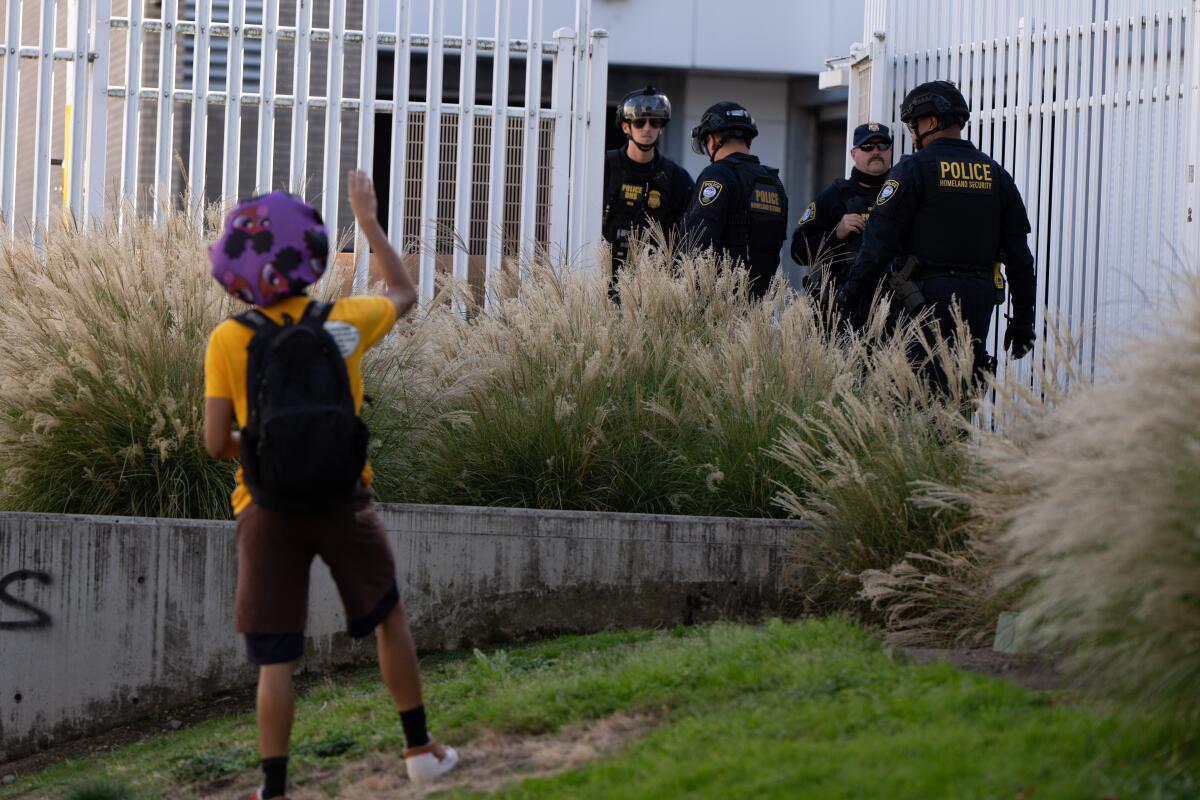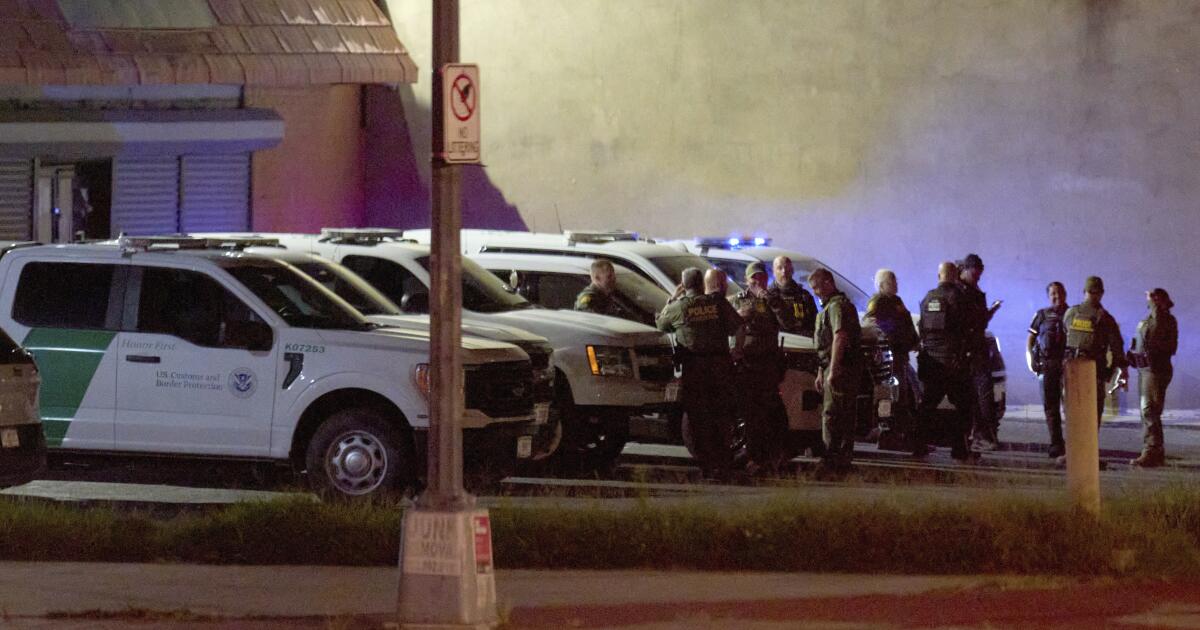Portland residents bewildered by Trump’s National Guard deployment
PORTLAND, Ore. — There is a rhetorical battle raging here in this heavily Democratic city, known for its delicious coffee, plethora of fancy restaurants, bespoke doughnuts and also for its small faction of black-clad activists.
It started Saturday when President Trump suddenly announced that he was sending the National Guard to “war-ravaged” Portland — where a small group of demonstrators have been staging a monthslong protest at an Immigration and Customs Enforcement building south of downtown.
Oregon officials have pushed back forcefully, flooding their own social media with images of colorful cafe tables, sun-drenched farmers markets, rose gardens in full bloom and parks bursting with children, families and frolicking dogs. Officials would prefer the city be known for its Portlandia vibe, and are begging residents to stay peaceful and not give the Trump administration a protest spectacle.
A protester waves to Department of Homeland Security officials as they walk to the gates of the U.S. Immigration and Customs Enforcement facility after inspecting an area outside in Portland, Ore.
(Jenny Kane / Associated Press)
“There is no need or legal justification for military troops,” Oregon Gov. Tina Kotek has said, over and over again, on her Instagram and in texts to President Trump that have been released publicly. Officials have gone to court seeking an order to stop the deployment, with a hearing set for Friday.
But the president seems resolute. In a Tuesday speech before a gathering of generals and admirals, he sketched out a controversial vision of dispatching troops to Democratic cities “as training grounds for our military” to combat an “invasion from within.” He described Portland as “a nightmare” that “looks like a warzone … like World War II.”
“The Radical Left’s reign of terror in Portland ends now,” a White House press release read, “with President Donald J. Trump mobilizing federal resources to stop Antifa-led hellfire in its tracks.”
Trump’s targeting of Portland comes after he deployed troops to Washington, D.C., and Los Angeles, and threatened to do so elsewhere. The president says he is delivering on campaign pledges to restore public safety, but detractors say he’s attempting to intimidate and provoke Democratic strongholds, while distracting the nation from his various controversies.
As they wait to see whether and when the National Guard will arrive, city residents this week reacted with a mixture of rage, bafflement and sorrow.
A man rests under a public art sculpture in downtown Portland, Ore.
(Richard Darbonne / For The Times)
Many acknowledged that Portland has problems: Homelessness and open drug abuse are endemic, and encampments crowd some sidewalks. The city’s downtown has never recovered from pandemic closures and rioting that took place during George Floyd protests in 2020.
More recently, Intel — one of Oregon’s largest private employers — announced it was laying off 2,400 employees in a county just west of Portland. Like Los Angeles and many other cities, Portland has seen a big drop in tourism this year, a trend that city leaders say is not helped by Trump’s military interventions.
“We need federal help to renew our infrastructure, and build affordable housing, to help clean our rivers and plant trees,” said Portland Mayor Keith Wilson on his social media. “Instead of help, they’re sending armored vehicles and masked men.”
All across the city this week, residents echoed similar themes.
“Nothing is happening here. This is a gorgeous, peaceful city,” said Hannah O’Malley, who was snacking on french fries at a table with a view of the Willamette River outside the Portland Sports Bar and Grill.
Patrons are reflected in the window at Honey Pearl Cafe PDX in downtown Portland.
(Richard Darbonne / For The Times)
The restaurant was just a few blocks from an Immigration and Customs Enforcement building where the ongoing demonstration has become the latest focus of the president’s ire against the city.
A small group of people — a number of them women in their 60s and 70s with gray braids and top-of-the-line rain jackets — have been congregating here for months to protest the federal immigration crackdown.
In June, there were several clashes with law enforcement at the site. Police declared a riot one night, and on another night made several arrests outside the facility, including one person accused of choking a police officer. On Tuesday, the Department of Homeland Security announced that they had arrested “four criminal illegal aliens” who allegedly conducted laser strikes on a Border Patrol helicopter “in an attempt to temporarily blind the pilot.”
But day in and day out, the protests have been largely peaceful and fairly small and nothing the city’s police force can’t handle, according to city officials and the protesters themselves.
On Monday afternoon, a group of about 40 people including grandmothers, parents and their children, and a man in a chicken costume, held flowers and signs. A few yelled abuse through a metal gate at ICE officers standing in the driveway.
People protest outside a U.S. Immigration and Customs Enforcement facility on Sept. 28 in Portland, Ore.
(Jenny Kane / Associated Press)
“We’re so scary,” joked Kat Barnard, 67, a retired accountant for nonprofits who said she began protesting a few months ago, fitting it in between caring for her grandson. She added that she has found a sense of community while standing against the Trump administration’s immigration crackdown. “I’ve met so many people,” she said. “It’s just beautiful. It makes me happy.”
A few miles away, in the cafe at the city’s famed bookstore, Powell’s Books, a trio of retired friends bemoaned their beloved city’s negative image.
“This is the most peaceful, kind community I’ve ever lived in” said Lynne Avril, 74, who moved to Portland from Phoenix a few years ago. Avril, a retired illustrator who penned the artwork for the young Amelia Bedelia books, said she routinely walks home alone late at night through the city’s darkened streets, and feels perfectly safe doing so.
The president “wants another spectacle,” added Avril’s friend, Signa Schuster, 73, a retired estate manager.
“That’s what we’re afraid of,” answered Avril.
“There’s no problem here,” added Annie Olsen, 72, a retired federal worker. “It’s all performative and stupid.”
Still, the women said, they are keenly aware that their beloved city has a negative reputation nationally. Avril said that when she told friends in Phoenix that she had decided to move to Portland, “People were like: ‘Why would you move here [with] all the violence?’”
Olsen sighed and nodded. “So much misinformation,” she said.
In the front lobby of the famed bookstore, the local bestseller lists provided a window into many residents’ concerns. Two books on authoritarianism and censorship — George Orwell’s “1984” and Ray Bradbury’s “Fahrenheit 451” — were on the shelves. Over in nonfiction, it was the same story, with “How Fascism Works” and “On Tyranny” both making appearances.
The Willamette River runs through downtown Portland, Ore.
(Richard Darbonne / For The Times)
But outside, the sky was blue and bright despite the rain in the forecast and many residents were doing what Portlanders do with an unexpected gift from the weather gods: They were jogging and biking along the Willamette River, and sitting in outdoor cafes sipping their city’s famous coffee and nibbling on buttery pastries.
“Trump is unhinged,” said Shannon O’Connor, 57. She said that Portland has problems for sure — “homelessness, fentanyl, a huge drug problem” — but unrest is not among them.
Sprawled on a sidewalk near a freeway on-ramp, a man calling himself “Rabbit” was panhandling for money accompanied by his two beagle-pit bull mixes, Pooh Bear and Piglet.
Rabbit, 48, said he hadn’t heard of the president’s plan to send in the National Guard, but didn’t think it was necessary. He had come to Portland two years ago “to get away from all the craziness,” he said, and found it to be safe. “I haven’t been threatened yet,” he said, then knocked on wood.
Many residents said they think the president may be confusing what is happening in Portland now with a period in 2020 in which the city was briefly convulsed over Black Live Matter protests.
“We had a lot of trouble then,” said a woman who asked to be referred to only as “Sue” for fear of being doxed. “Nothing like that now.” A lifelong Portlander, she is retired and among those who have been demonstrating at the ICE facility south of downtown.
She and other residents said they have noticed that clips of the riots and other violence from 2020 have recently been recirculating on social media and even some cable news shows.
“Either he is mistaken or it is part of his propaganda,” she said of the president’s portrayal of Portland, adding that it makes her “very sad. I’ve never protested until this go-around. But we have to do something.”
As afternoon turned to evening Tuesday, the blue skies over the city gave way to clouds and drizzle. The parks and outdoor cafes emptied out.
As night fell, the retired women and children who had been protesting outside the ICE facility went home, and more and more younger people began to take their places.
By 10 p.m., law enforcement was massed on the roof of the ICE building in tactical gear. Black-clad protesters — watched over by local television reporters and some independent media — played cat and mouse with the officers, stepping toward the building only to be repelled by rounds of pepper balls.
A 39-year-old man, who asked to be called “Mushu” and who had only his eyes visible amid his black garb, stood on the corner across the street, gesturing to the independent media livestreaming the protests. “They are showing that hell that is Portland,” he said, his voice dripping with irony.
About the same time, Katie Daviscourt, a reporter with the Post Millennial, posted on X that she had been “assaulted by an Antifa agitator.” She also tweeted that “the suspect escaped into the Antifa safe house.”
A few minutes later, a group of officers burst out of a van and appeared to detain one of the protesters. Then the officers dispersed, and the standoff resumed.
Around the corner, a couple with gray hair sporting sleek rain jackets walked their little dog along the street. If they were concerned about the made-for-video drama that was playing out a few yards away, they didn’t show it. They just continued to walk their dog.
On Wednesday morning, the president weighed in again, writing on Truth Social, “Conditions continue to deteriorate into lawless mayhem.”

